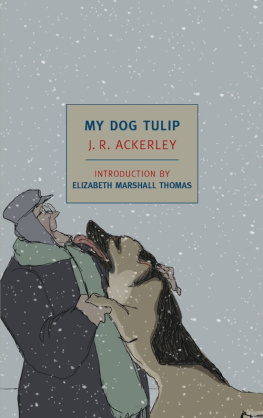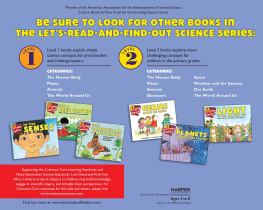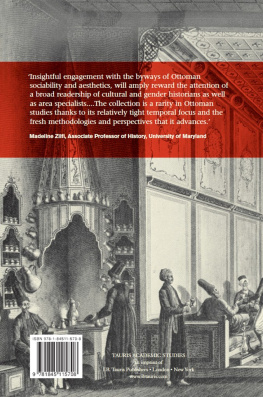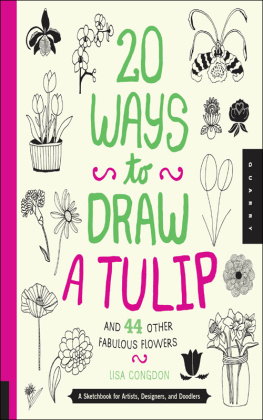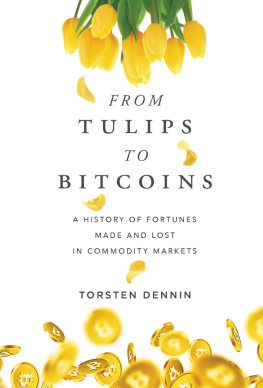Ackerley Joe Randolph - My Dog Tulip
Here you can read online Ackerley Joe Randolph - My Dog Tulip full text of the book (entire story) in english for free. Download pdf and epub, get meaning, cover and reviews about this ebook. City: New York;NY;Great Britain, year: 2010;2011, publisher: New York Review Books, genre: Art. Description of the work, (preface) as well as reviews are available. Best literature library LitArk.com created for fans of good reading and offers a wide selection of genres:
Romance novel
Science fiction
Adventure
Detective
Science
History
Home and family
Prose
Art
Politics
Computer
Non-fiction
Religion
Business
Children
Humor
Choose a favorite category and find really read worthwhile books. Enjoy immersion in the world of imagination, feel the emotions of the characters or learn something new for yourself, make an fascinating discovery.
- Book:My Dog Tulip
- Author:
- Publisher:New York Review Books
- Genre:
- Year:2010;2011
- City:New York;NY;Great Britain
- Rating:5 / 5
- Favourites:Add to favourites
- Your mark:
- 100
- 1
- 2
- 3
- 4
- 5
My Dog Tulip: summary, description and annotation
We offer to read an annotation, description, summary or preface (depends on what the author of the book "My Dog Tulip" wrote himself). If you haven't found the necessary information about the book — write in the comments, we will try to find it.
My Dog Tulip — read online for free the complete book (whole text) full work
Below is the text of the book, divided by pages. System saving the place of the last page read, allows you to conveniently read the book "My Dog Tulip" online for free, without having to search again every time where you left off. Put a bookmark, and you can go to the page where you finished reading at any time.
Font size:
Interval:
Bookmark:
J.R. ACKERLEY (18961967) was for many years the literary editor of the BBC magazine The Listener. His works include three memoirs, Hindoo Holiday, My Dog Tulip, and My Father and Myself, and a novel, We Think The World of You (all available as New York Review Books).
ELIZABETH MARSHALL THOMAS is the author of The Hidden Life of Dogs.
Who would imagine that the bodily eliminations, impacted anal glands, and sexual dysfunction of an ordinary dog could inspire a story so delicate, so sensitive, so clearly understood, and so purely and delightfully composed as to rival an Elizabethan sonnet? This tiny book, first printed as a very limited edition in England in 1956, has won the praise of such literary giants as Julian Huxley and E.M. Forster and continues to pop up on lists of the best books about animals and even of the twentieth century. And yet the most striking and dramatic aspect of it is the outright banality of the story it has to tell.
The subject of this wonderful book is an unspayed German shepherd bitch, Tulip, who was somewhat undertrained by normal standards, as she made free with rugs and furniture and sometimes threatened to bite. Otherwise, she lived an ordinary, quiet life in a London apartment. Her owner, J.R. Ackerley, seems ordinary too. Although he was for many years a distinguished editor and author in British literary circles, he appears in these pages simply as Tulips owner, a bachelor taking his dog for walks and to the veterinarian, doting and worrying just as any other dog owner would do.
If the book is remarkable, Tulip was not. She wasnt a Lassie or a Rin Tin Tin. Far otherwise, as I learned from a publisher who had actually met her. He said quite frankly that she was a terror, and though Ackerley doesnt entirely veil that fact, according to him he doesnt tell us the half of it. Evidently, her behavior was so awful that Ackerleys friends stopped visiting him, and, since he insisted on bringing Tulip with him wherever he went, they soon stopped inviting him to visit them. If they did once, they didnt make the same mistake again. They didnt want their cats chased, their rugs soiled, and their homes taken over. They seemed to resent being challenged whenever they approach[ed] their own sitting or dining rooms, as Ackerley himself puts it.
In 1965, when My Dog Tulip was published in the United States, Freud was in high vogue, and nearly everybody saw subconscious motivation in nearly everybody else. Popular theory at the time held that Ackerley let his dog act out his antisocial sentiments. But in my opinion, he did nothing of the kind. Any antisocial tendencies that Ackerley may display in these pages are the result of his being pro-dog. When people and his dog come into conflict, he sides with the dog, and most of his readers will applaud him for it. Some, including myself, can derive much satisfaction from learning how Ackerley diminished the kind of people at whose hands we and our dogs have sufferedthe people who might be called the dog fascists. Whats the bleeding street for? shouts an irate cyclist as the gracefully squatting Tulip fouls the sidewalk. For turds like you, retorts Ackerley. Yes! cries the reader. Thats exactly what the bleeding street is foridiots like that cyclist who would have our beloved dogs risk their lives in traffic! Yet satisfactory as they are, such vicarious triumphs do not exhaust the appeal or explain the power of Tulips biography. What, then, is its secret?
Most of us who take a strong interest in animals came to do so because of our pets, with whom we feel a certain kinship. Our ardor has set off an avalanche of books about animals, almost all of them monumentally unsatisfying. Works with an ecological bent often treat animals as features of the landscapefauna. Works with a biological focus tend to present animals for their generalized behavior, as if each were merely the epitome of its species. On the rare occasions that individual animals are discussed, they must have done a person or persons some servicelike the famous Baldy of Nome who led a dog team that brought medicine to an isolated Alaskan community. Thanks to the general misimpression that animals are on earth for our use, the service, not the animal, becomes the focus. Worse yet, fictional animals are seldom animals at all. Bambi and Lassie take the prize for anthropomorphization, and even Stuart Little, for all his charm, is human, not murine.
To see the shortcomings of these approaches, we might imagine them applied to human beings. When we read about people, we want to see them in our minds eye, to know who they are and how they experience their problems and manage their relationships. We want insights we can apply to ourselves and characters with whom we can identify. But if the books about people were anything like most books about animals, every discussion of a character would be limited to questions of appearance and food supply, every biography would exhaust itself in a single act of heroism, and literature would be reduced to stories about Wonder Woman (the human equivalent of Lassie) and to amusing tales for children in which people, reverse Stuart Littles, behave like mice. In any case, none of it would provide either the pleasure or the complexity that we expect from reading, and no doubt we would soon lose interest and turn to other pastimes.
Enter Tulip, threading her way down a sidewalk on the end of a leash, her long, black nose delicately reading, one by one, the messages sprinkled on the bushes by others of her kind. She is a slave, yes, as are all domestic animals, and must ultimately do as her owner wishes, yet she attends to her own needs as best she can within those confines. If she must add her mark to those she finds along the sidewalk, she calmly does so, splendidly ignoring the doings of our species, just as we would probably have ignored her had we happened to pass by. But thanks to Ackerley, we see her, and what an interesting creature she is! She has free will. She has preferences. She has personality. Perhaps she misbehaves occasionally, but only when her standards as a dog override our human ones.
But the great thing about this book is that by presenting Tulip in all her matter-of-factness it preserves her mystery. Obviously Ackerley loves her deeply, but he never asks us to do the same (this is perhaps a first in writings about pet animals). Theres a certain proprietary exclusiveness, a trace of jealousy in his attitude: its as if he were saying, I love her even if shes bad, and you cant. Nor does he ask us to understand her. He doesnt, and again, we cant. Shes a dog, not a person, and we dont know enough about dogs or other animals to fathom her ways. When she fails to find a mate of her liking, try as she will, we recognize her desire but her difficulty confounds us. What a dog might understand at once, we find mystifying. So we look on, fascinated, as she makes her innocent, determined way through the maze of requirements and prohibitions that our species inflicts upon hers. And yet so realistically and respectfully does Ackerley portray Tulip that we feel for her just as much as we might for any human heroine.
Nobody who reads My Dog Tulip forgets it. It has no paradigm and belongs to no genre. No use to talk about its sensitivity, its underlying passion, its diamond eye, its devilish wit, and its flexible, compelling prose. Plenty of books about people have these attributes, or at least some of them. But very few writers with Ackerleys ability use their talents on subjects which are as remote from human understanding as a member of another species, or, for that matter, as humble as a dog. Tulip is an individual, as unknowable as she is familiar, and as such she is all dogs, all pets, and, in the end, all animals in their marvelous complexity, among us but not of us, with their intricate, mysterious lives.
Next pageFont size:
Interval:
Bookmark:
Similar books «My Dog Tulip»
Look at similar books to My Dog Tulip. We have selected literature similar in name and meaning in the hope of providing readers with more options to find new, interesting, not yet read works.
Discussion, reviews of the book My Dog Tulip and just readers' own opinions. Leave your comments, write what you think about the work, its meaning or the main characters. Specify what exactly you liked and what you didn't like, and why you think so.

